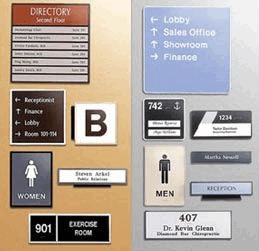Discovering the Secret Features of ADA Indicators for Boosted Availability
In the realm of access, ADA indications serve as silent yet effective allies, guaranteeing that rooms are comprehensive and accessible for individuals with handicaps. By integrating Braille and responsive components, these indicators break obstacles for the visually impaired, while high-contrast color plans and legible font styles provide to diverse aesthetic needs.
Relevance of ADA Compliance
Making sure compliance with the Americans with Disabilities Act (ADA) is important for cultivating inclusivity and equal gain access to in public rooms and work environments. The ADA, established in 1990, mandates that all public centers, companies, and transport solutions accommodate individuals with specials needs, guaranteeing they enjoy the exact same civil liberties and opportunities as others. Compliance with ADA requirements not just meets legal responsibilities however additionally enhances an organization's online reputation by showing its commitment to diversity and inclusivity.
Among the essential elements of ADA conformity is the application of obtainable signs. ADA indicators are designed to ensure that individuals with disabilities can conveniently browse via rooms and buildings. These indications need to follow certain standards pertaining to dimension, typeface, shade comparison, and placement to guarantee visibility and readability for all. Appropriately carried out ADA signage helps remove obstacles that individuals with specials needs commonly run into, therefore advertising their freedom and self-confidence (ADA Signs).
In addition, adhering to ADA policies can mitigate the danger of prospective fines and lawful repercussions. Organizations that stop working to abide by ADA standards may face legal actions or fines, which can be both harmful and economically burdensome to their public picture. Thus, ADA conformity is integral to cultivating an equitable setting for everybody.
Braille and Tactile Components
The incorporation of Braille and responsive components into ADA signage symbolizes the principles of accessibility and inclusivity. It is usually positioned under the corresponding text on signs to guarantee that individuals can access the info without aesthetic aid.
Responsive aspects expand beyond Braille and consist of increased symbols and characters. These parts are designed to be noticeable by touch, allowing people to determine space numbers, bathrooms, departures, and other crucial areas. The ADA sets specific standards regarding the size, spacing, and positioning of these responsive elements to enhance readability and make sure uniformity across various settings.

High-Contrast Color Design
High-contrast color pattern play a crucial function in improving the visibility and readability of ADA signs for people with aesthetic disabilities. These schemes are essential as they make the most of the difference in light reflectance between message and background, ensuring that indicators are easily noticeable, even from a range. The Americans with Disabilities Act (ADA) mandates making use of certain color contrasts to fit those with limited vision, making it a crucial element of conformity.
The effectiveness of high-contrast shades hinges on their capacity to stand out in different lights conditions, consisting of dimly lit settings and areas with glare. Typically, dark text on a light background or light message on a dark background is utilized to attain ideal comparison. Black message on a white or yellow background gives a stark visual distinction that assists in quick acknowledgment and understanding.

Legible Fonts and Text Size
When taking into consideration the layout of ADA signs, the selection of clear typefaces and ideal message dimension can not be overstated. These components are important for making sure that signs come to people with aesthetic problems. The Americans with Disabilities Act (ADA) mandates that typefaces must be sans-serif and not italic, oblique, script, extremely ornamental, or of uncommon type. These demands assist make sure that the text is quickly readable from a distance and that the personalities are distinct to diverse audiences.
According to ADA guidelines, the minimum text height ought to be 5/8 inch, and it should boost proportionally with seeing range. Consistency in text dimension contributes to a natural visual experience, helping people in navigating atmospheres successfully.
Moreover, spacing between lines and letters is essential to legibility. Appropriate spacing prevents personalities from appearing crowded, improving readability. By adhering to these requirements, developers can substantially improve availability, making sure that our website signs offers its designated objective for all individuals, regardless of their visual capacities.
Efficient Positioning Strategies
Strategic positioning of ADA signage is essential for optimizing availability and ensuring conformity with lawful criteria. ADA standards state that indications ought to be mounted at an elevation in between 48 to 60 inches from the ground to guarantee they are within the line of sight for both standing and seated individuals.
In addition, signs have to be placed beside the lock side of doors to enable easy recognition before entry. This placement aids people locate rooms and areas without obstruction. In cases where there is no door, indicators need to be located on the closest nearby wall surface. Consistency in sign positioning throughout a facility boosts predictability, minimizing confusion and boosting general user experience.

Conclusion
ADA signs play an important function in promoting access by integrating features that resolve the requirements of people with specials needs. These components jointly promote an inclusive environment, underscoring the importance of ADA conformity in making certain Your Domain Name equivalent accessibility for all.
In the world of access, ADA indicators offer as silent yet effective allies, guaranteeing that areas are inclusive and accessible for people with specials needs. The ADA, passed in 1990, mandates that all public centers, employers, and transport services accommodate people with specials needs, ensuring they take pleasure in the exact same rights and possibilities as others. ADA Signs. ADA indications read are created to make certain that people with disabilities can easily navigate via buildings and rooms. ADA guidelines stipulate that indicators must be placed at a height in between 48 to 60 inches from the ground to ensure they are within the line of view for both standing and seated individuals.ADA indications play a vital duty in promoting access by integrating features that resolve the demands of individuals with handicaps